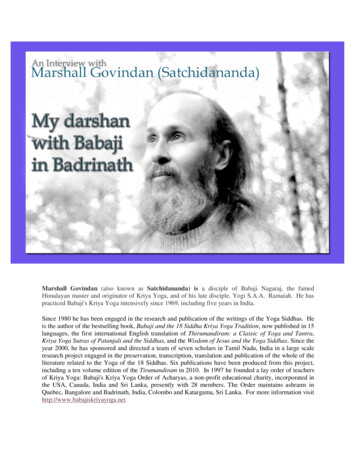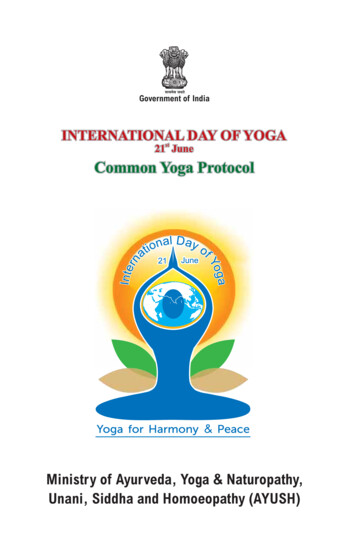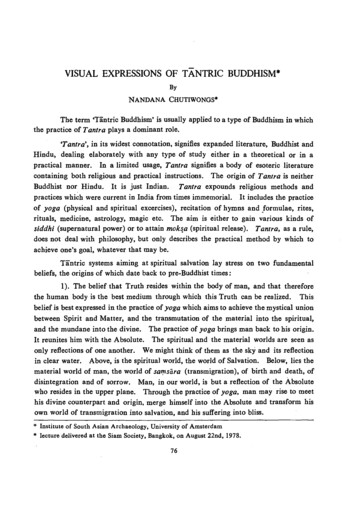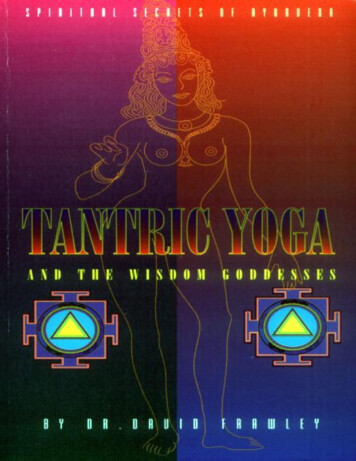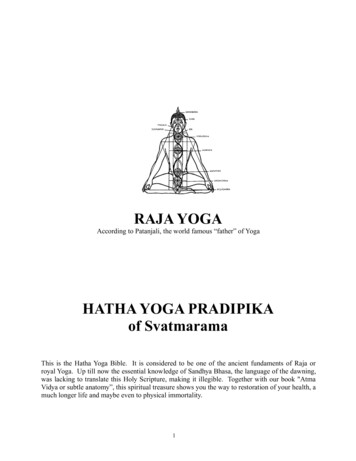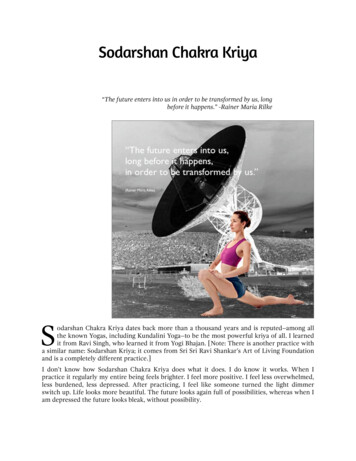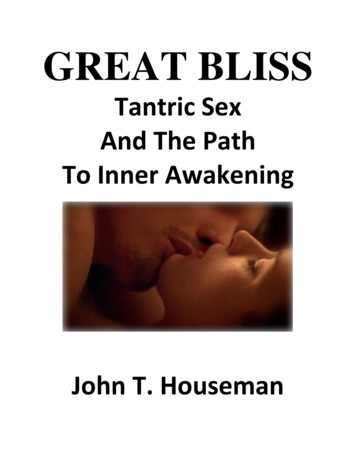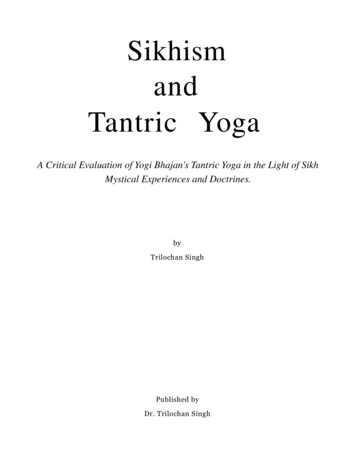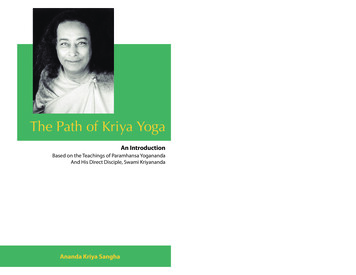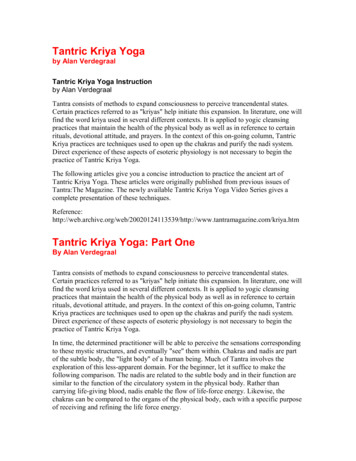
Transcription
Tantric Kriya Yogaby Alan VerdegraalTantric Kriya Yoga Instructionby Alan VerdegraalTantra consists of methods to expand consciousness to perceive trancendental states.Certain practices referred to as "kriyas" help initiate this expansion. In literature, one willfind the word kriya used in several different contexts. It is applied to yogic cleansingpractices that maintain the health of the physical body as well as in reference to certainrituals, devotional attitude, and prayers. In the context of this on-going column, TantricKriya practices are techniques used to open up the chakras and purify the nadi system.Direct experience of these aspects of esoteric physiology is not necessary to begin thepractice of Tantric Kriya Yoga.The following articles give you a concise introduction to practice the ancient art ofTantric Kriya Yoga. These articles were originally published from previous issues ofTantra:The Magazine. The newly available Tantric Kriya Yoga Video Series gives acomplete presentation of these tmTantric Kriya Yoga: Part OneBy Alan VerdegraalTantra consists of methods to expand consciousness to perceive trancendental states.Certain practices referred to as "kriyas" help initiate this expansion. In literature, one willfind the word kriya used in several different contexts. It is applied to yogic cleansingpractices that maintain the health of the physical body as well as in reference to certainrituals, devotional attitude, and prayers. In the context of this on-going column, TantricKriya practices are techniques used to open up the chakras and purify the nadi system.Direct experience of these aspects of esoteric physiology is not necessary to begin thepractice of Tantric Kriya Yoga.In time, the determined practitioner will be able to perceive the sensations correspondingto these mystic structures, and eventually "see" them within. Chakras and nadis are partof the subtle body, the "light body" of a human being. Much of Tantra involves theexploration of this less-apparent domain. For the beginner, let it suffice to make thefollowing comparison. The nadis are related to the subtle body and in their function aresimilar to the function of the circulatory system in the physical body. Rather thancarrying life-giving blood, nadis enable the flow of life-force energy. Likewise, thechakras can be compared to the organs of the physical body, each with a specific purposeof receiving and refining the life force energy.
Tantric Kriyas are techniques that a single individual can do to accelerate his or herspiritual growth. If one has tried to quiet chatter of the mind through meditation with littlesuccess, Tantric Kriyas will provide surprising results because no effort is put intostopping the mind. On the contrary, the mental mechanism can do whatever it wants. AsKriyas begin to purify the subtle body, emotions will arise, thoughts will occur -- just letthem happen. It is all part of the healing process necessary to become open to highervibrational energies. Over time, these emotional releases will be replaced by clarity,energy experiences, and even visions. Just continue to do the practices.There is a secret koan whose understanding leads to success in seated meditation -"when the body is still, always keep moving." Think about it. Even when one is sittingquietly, there is much movement that is on-going. The lungs continue to breathe, theheart continues to pump, the eyes blink if they are open. Being aware of this subtlemovement is a meditation in itself. A common yogic meditation technique is to observethe breath. Take a moment and observe your breath. Focus on your nose. What do younotice? As you breathe in, there is a cooling sensation in the nostrils. As you breathe out,there is a warming sensation. If one continues with this meditation, the mind will soonget bored. At first, the mind will be interested, "Hey, I do notice the cooling and warmingsensation. That's neat." If you persist with the meditation, the mind will start to rebel.Other thoughts will occur, and soon you will have forgotten totally about observing thebreath as the mind goes off day-dreaming. Suddenly, you may remember, and reestablish the focus on the breath and nose. Soon however, the mind will be off on its ownjourney, making success with this seemingly simple meditation very difficult.In Tantric Kriya Yoga, two allies are enlisted to facilitate meditation and tap quickly intothe subtle energies. The first ally is the breath. The breathing process never stops. Thepractitioner can control the breath, and through this control, influence the body, theemotions, and the mind. All of these are connected. When one is aroused, breathingspeeds up. When one is angry, one tenses and holds the breath. When the mind ispeaceful, the breathing is regular and deep. These are simple breathing responses to thestate of the body, a direct cause and effect reaction. What is worth some exploration is theopposite relationship. Let the tail wag the dog. When one is angry -- breathe. Byconsciously altering the breath, there will be a definite effect upon the body, theemotions, and the mind. This is one of the most important observations in yoga. This isthe goal of pranayama -- the science of mastering the breath. There are many techniques,but for the beginner, the rule is very simple -- breathe. It could change one's life. Withoutit, there is no life.The second ally is awareness. The term kriya means "action" in Sanskrit. Even though thebody is quiet, in Tantric Kriya Yoga, awareness always keeps moving. Awareness is asensation, almost a tingling, that is localized to a specific spot or site. Look at your righthand. What do you feel there? Blow on it. Almost immediately, sensations from yourhand flood into your brain. Move this "awareness" to the tip of the first finger. Feel thesensations specific to your finger tip. All other sensations are forgotten. The brain is stillreceiving them, but awareness allows us to narrow the rush of sensory input selectively.We can consciously choose what input we want to experience. This is the power ofawareness. What is your left hand doing? Immediately you feel the sensations coming
from your left hand. What is your right foot doing? What about your left ear? Awarenesscan move. It can move very quickly. It can move very slowly.These two allies, breath and awareness, can be linked together to form the powerful seriesof techniques called Tantric Kriyas. When linked with the breath, awareness can movelife-force energy through certain channels in the body. In the beginning, we do mean thephysical body, since awareness initially is physically oriented. After steady practice, onewill become aware nadis and chakras, and the movement of energy in the subtle body.Meditation: We want to learn to connect the breath and the awareness together. Go backto the very first exercise -- observing the breath. This time, as you breathe in, move yourawareness along with the first wisps of air entering your body. As you begin your inhale,become aware of the air entering your nostrils, follow it around the nasal passage, passedthe glottis, down the bronchial tubes, all the way into the lungs, to where it expandsagainst the diaphram. You can actually feel sensations all of the way. Now exhale andbring your awareness back outward with the breath, such that it reaches your nose withyour last bit of air. Inhale again and move your awareness. Close your eyes, it may helpyou to focus a little more on your awareness. The goal in this practice is to get used tomoving the awareness in conjunction with the breath. An interesting thing will happen,your mind may wander, thoughts may occur, but you can still maintain awareness of thesensations along your respiratory passage as the breath goes in and out. Another thing hashappened, your breathing has become deep and regular. Let the thoughts just occur. Thisseparation of the thought process from the breathing and awareness is a naturalphenomenon. There is no need to force the mind to stop thinking. You have joined twogreat allies that can overcome many obstacles along the inward path to transcendence.There is a breathing technique that is very essential to doing the Tantric Kriya practices.In yoga, it is called ujjayi breath. As you breath in, slightly contract the glottis. You willknow you are doing this correctly when you feel a gentle constriction that will cause aslightly audible rasping sound, almost like a quiet snore. The constriction should not beso tight as to restrain the air forcefully. It can be very subtle and smooth. If you arehaving problems experiencing this sensation, contact a yoga teacher for a demonstration;it is a very common yogic technique. Once you understand how to do it, it will comeeasily. There is a very important physiological phenomenon that occurs when ujjayibreath is practiced. The breathing slows down and the blood pressure is lowered in thebody. This naturally relaxes the body allowing one to feel comfortable in the inwardstate. Closing the eyes will intensify the experience. It is almost as if one is asleep, butinside thoughts continue to happen.Practice ujjayi with the awareness of the breath filling and vacating the lungs as describedabove. This is the very first Tantric Kriya practice. There are many many Kriya practices.Most mystical traditions incorporate Kriya practices for reaching higher states. Thiscolumn will present these practices starting with the simple ones and advancing to morecomplex techniques that move energy and undertake specific visualizations. Tantrikasview the body as a laboratory and Kriyas as the tools for experimentation. Regularpractice will help you relax your physical body, become aware of your subtle body,
expand your consciousness, and experience drug-less states of trancendence.There is a mythology about Kriya practices made popular through ParamahansaYogananda's book, Autobiography of a Yogi. Over a thousand years ago, a man namedBabaji obtained perfection in his practice of Kriyas. He transcended all his karmas andbecame a Mahasiddha, a Great Saint, an Immortal beyond the physical limitations of thebody. Rather than merging with the trancendental reality, he remained on the ethericplane to help aspirants along the path of spiritual awakening. Over time, the Kriyatechniques were lost or forgotten. During the nineteenth century, Mahasiddha Babajidecided it was time once again for people to practice Kriyas. He appeared to manyspiritual saints, including Yogananda's Sadguru Lahiri Mahasay. Revealing thetechniques, he re-established the Kriya techniques in many different lineages andtraditions. It is not important what school of yoga or lineage you follow, Tantric Kriyasare in all mystic traditions. It is said that there are 108 Kriyas, 72 are practices that theindividual does alone, the other 36 are practices to be done with a partner.Alan VerdegraalPublisher, TANTRA: The Magazine(Reprinted with permission from TANTRA: The Magazine, Issue 1, page 16-17, 1991.)Tantric Kriya Yoga: Part TwoBy Alan VerdegraalThis section will present a new principle, called psychic breathing, and introduce thepractice of Chakra Breathing, that will energize and begin the purification of the chakrasand other specific energy points in the subtle body.In Part One ww.tantramagazine.com/kriya/k 01.htm , several principles and practices have been introduced. One of these is awareness,the ability of the brain to single out specific sensory input from a particular location ofthe body and willfully move that awareness from point to point. The second is breathing,whose power is the key to an entire set of yogic practices called pranayamas. Whenjoined together, awareness and breathing combine as two great allies to form the basis ofmany Tantric Kriya Yoga techniques. A particular pranayama was introduced calledujjayi breath, faciliated by the slight contraction of the glottis, that naturally lowers theblood pressure and slows down the cycle of the breath that assists one to easily focusinward. If you have experimented with the exercises presented, you will have found howeasy it is to go into a relaxed meditative state, possibly deeper than you have gone before.Many Kriya techniques are formed through the combination of these three activities, slowdeep breathing, contraction of the glottis, and the movement of awareness. For thebeginning practitioner, when we speak of awareness, we are referring to the awareness ofsensations in the physical body. Over time, Kriya practices will sensitize the individual tothe experience of the subtle body which includes the nadis and chakras. Specific channels
will be identified and utilized in various practices that will be presented in forthcominglessons. In advanced techniques, when the mind has been cleared of chatter andemotional thought patterns, specific visualizations will be employed. However, we muststart with the basics upon which many techniques will be built.Certain knowledge of the subtle body is required before one can begin the practice ofTantric Kriya Yoga. This information includes the approximate location of the chakrasand other key energy points. Only the most basic fundamentals will be presented here, forit is up to the serious practitioner to experience for him or herself. The key to success isregularity, not how much one spends at a particular meditative session. Fifteen minutesonce a week every week is much better than one hour every now and then. Fifteenminutes every day is a good goal for the beginner, but it is OK if you only do it once aweek. We will be adding at least one technique a lesson, and you will find the length ofyour Kriya meditations extending naturally.It is important to note that different spiritual traditions present disparate informationconcerning the structure of the subtle body including the chakras and nadi system. Eachtradition including Hindu, Buddhist, and Taoist, mention the subtle body in ancientsacred texts, but tend to disagree on the number of chakras and their attributes. Forinstance the East Indian Tantric system generally states that there are 7 chakras, while theBuddhists mention only 5. In their book, The Body of Light, Lar Short and Thomas Manndiscuss this phenomenon and present possible explanations. Their final advice is mostimportant: Do not let this be an obstacle. After years of Kriya practice, I have identifiedno less that 20 energy points that have become part of my psychic being. These pointsmade themselves known to me over time as I increased my sensitivity. One can start withany of the systems, but let your own experience be the guide by tuning into your innerbeing.With this in mind, a good starting point is the East Indian Tantric system. For those whodo desire a more complete explanation of this tradition, there are several excellentWestern texts that discuss the chakras with related techniques and meditations. Theclassic is Kundalini Yoga for the West by Swami Sivananda Radha (Shambhala). Anotheris Wheels of Life by Anodea Judith (Llewellyn) and more recently, Chakras by one of myteachers, Harish Johari (Destiny Books). These three will give the reader more thanadequate coverage of the chakras and their associated attributes. These attributes includesounds, senses, emotions, symbols, colors, elements, desires and obstacles. Once again,however, don't let book study circumvent your own direct experiences. What youexperience is your reality; books can only present vague maps to those who seek the wayto transcendence.One of the purposes of Kriya Yoga is to open and purify the chakras, nadis, and channels.This will allow life force energy to flow easily through these centers and systems.Though chakras and nadis are not physical in nature, that is, they are not to be found inthe physical body, when they become energized there are bodily sensations that occur onthe physical level. These sensations include warmth, tingling, pulsing, pressure, etc. AsKriya practices take the aspirant into deeper states of consciousness, one's awareness ofthese sensations will begin to refine and become very localized. At first the sensationsmay be experienced coming from a very large area of the physical body rather than a
point. At other times, it may seem that the loci of the sensations keep moving about witheach session. Just continue the focus on the places where the sensation seems thestrongest and detach from any intellectual correspondence with what you may have read.With practice, you will know in time exactly where your energy points are located.Take a moment to examine the diagram and identify various terms, such as chakras,kshetrams, and bindu, and energy points. The chakras consist of the following:Muladhara, Swadhisthana, Manipura, Anahata, Vishuddi, Ajna, and Sahasrara. These arethe Sanskrit transliterations. Knowing the Sanskrit names is not initially important butsomething to master over time. In men, Muladhara is located in the perineum between theanus and genitals. In women, it is located inside the vagina. The next four chakras arelocated along the spine. Ajna is located at the point between the eyebrows and Sahasrarais located at the top of the head, i.e., at the fontinel of the skull. There are certain pointscalled kshetrams that correspond to the four spinal chakras but occur at the front of thebody. For instance, Manipura chakra occurs on the spine behind the navel, while thekshetram for Manipura occurs at the navel. Likewise, Anahata chakra occurs behind theheart on the spine, while the kshetram for Anahata occurs in front of the heart on thechest. Vishuddi chakra is located at the back of the neck and its kshetram is located in thethroat. Sometimes the sensations at the kshetrams will feel far more pronounced thansensations at the corresponding chakra points taking in the entire abdomen, chest orthroat. There is one other special point, called Bindu, which is located on the back of theskull where the hair naturally spirals outward. This is also the point where monks willshave the hair to leave a bald spot for added stimulation.Chakra/Kshetram Awareness TechniqueOnce you have familiarized yourself with all of these points so that you do not have torefer to any chart, you are ready for the first practice. Sit in a comfortable position withthe back straight. This can be with crossed legs, in a half-lotus position, full lotus, orsimply sitting in a chair. In all of these positions, the buttocks should firmly make contactwith the ground or seat. If you are in a chair make sure that your back is not touching theback of the chair, for this will interfere with sensing the energy at the chakras.Focus on Muladhara chakra, that is, move your awareness to that point which is theperineum in men and the inside of the vagina in women. Just notice any sensations thatmight occur. Always start with Muladhara chakra and always end with bringing theawareness to Muladhara chakra. We will move the awareness from point to point byproceeding up the kshetrams in the front of the body and then down the chakras along thespine. So become aware of the point for Swadhisthana kshetram. It is located in both menand women near the pubic bone. Move to Manipura kshetram at the point of the navel.Now to Anahata kshetram in front of the heart, to Vishuddhi kshetram, to Ajna chakrabetween the eyebrows, to Sahasrara at the top of the head, to the Bindu point in back ofthe head, down to Vishuddhi chakra, Anahata chakra, Manipura chakra, Swadhisthanachakra, and finally back to Muladhara. Spend enough time at each point to notice anysensations, then go on to the next point. Continue this cycle around the body a dozen ormore times. We will now introduce the method of psychic breathing that when added tothe above chakra/kshetram awareness technique will make an extremely powerfulpractice.
Psychic BreathingPsychic Breathing is difficult to explain; it must be experienced. We are so used to thesensation of the breath going in and out of the nose and mouth, that it may be initiallydifficult to sense something different, especially something that violates our rationalconcept of breathing. Psychic breathing is when we focus our awareness at a specificpoint and imagine that there is an opening at that point. We imagine that the air isactually entering and exiting the body at that point. Another way of illustrating thistechnique is as follows. Imagine, for instance, that you have a big nose on your chest(where Anahata kshetram is located). Feel yourself breathe directly into your chestthrough this imaginary nose. Now exhale out of this "nose". Feel the sensations. Yourawareness stays at the point on the sternum; you are not focusing awareness on your noseor mouth. Breathe in, breathe out. Feel the heart and lungs fill with energy. Try it withanother point, such as your navel. Try a slow deep inhalation and exhalalation keepingyour awareness at your navel and imagine air moving in one direction, then out in theother direction. It will not take long before you will be "breathing" in and out of specificchakras and kshetrams.This is call psychic breathing because you are not actually breathing air in and out ofthese points. However, you are psychically breathing prana in and out of these points.Prana is a term that relates to life force energy and is necessary for all life. Typically, themain way we take prana into the body is through the physical breathing mechanism. Thatis not the only way. Psychic breathing will also move prana in and out of the body,especially at the various energy points (chakras, kshetrams, bindu). The more this ispracticed, the more prana will move, and the more sensations there will be as if you wereactually breathing air in and out of a specific point directly into the body.Chakra BreathingNow let's combine Psychic Breathing with the Chakra/Kshetram Awareness Technique.Place your awareness at Muladhara chakra and "pull" prana directly into the body as youslowly inhale. As you exhale, psychically breathe the prana out through Muladhara. Next,move up the front of the body with each kshetram (Swadhisthana, Manipura, Anahata,and Vishuddhi), breathing in and breathing out physically and psychically once with eachpoint. Notice the sensations. At first it will not be a single point of which you becomeaware, but more like an area. For example, you may feel sensations all over yourabdomen instead of just at the navel. Slowly these sensations will become more localizedto the navel and its immediately surrounding area. Continue the circuit to Ajna,Sahasrara, and Bindu, then down the chakras along the spine to Muladhara. Do the circuitagain and again. If you have perfected ujjayi breath, you may find that you areautomatically doing this technique in conjunction with the psychic breathing. This willtake you very deeply inward and your focus of awareness on each point will magnifygreatly. This is the Kriya practice called Chakra Breathing.There is one last technique or mudra that I will introduce in this section. This is thepractice of Khechari Mudra or the tongue lock. With the mouth closed, roll the tonguebackward so that the normally lower surface touches the upper palate. Try to bring thetongue tip as far back as possible without strain. At first it may seem awkward, but with
some practice in conjunction with ujjayi breath, it will actually seem like the most naturalposition for the tongue. This mudra has a very subtle effect upon both the physical andsubtle body. It actually connects two important circuits that we will discuss in the nextissue.Practice Chakra Breathing every day for ten or fifteen minutes. Your perception of thechakras, kshetrams and Bindu will greatly be enhanced. As these energy points beginbeing purified, you will find yourself feeling many different emotions or having manydifferent memories arise. This is a natural process. Let the memories and emotionshappen. If you want to cry, let it happen. For the first two years that I did Kriya practices,I cried almost every session. This is the natural release of emotional holding and karmicpatterning. This Kriya practice is very balanced for it energizes all the chakras andkshetrams. Focusing on just one chakra or kshetram for extended lengths of time is anunbalanced practice and can cause profound emotional swings. One of the objectives inTantra is balance. Tantric Kriya Yoga when properly practiced is a very balanced set oftechniques that expand the consciousness.Alan VerdegraalPublisher, TANTRA: The Magazine(Reprinted with permission from TANTRA: The Magazine, Issue 2, page 12-13, 1991.)Tantric Kriya Yoga: Part ThreeBy Alan VerdegraalPart Three introduces the frontal and spinal channels necessary for the practice KriyaChakra Circuit, that connects the chakras and kshetrams together in a single breath. In thePart Two ww.tantramagazine.com/kriya/k 02.htm , the location of the chakras and kshetrams were introduced as shown inthe accompanying diagram. Knowing the general position of these points is necessarybefore proceeding with the practice of Tantric Kriya Yoga. Review these locations. Thereare seven chakras, four kshetrams, and a special point called Bindu.Also in the last section, the practice of psychic breathing was explained. This is thetechnique of breathing prana in and out of a specific point and is best linked to the yogicbreathing method called ujjayi breath where the glottis is slightly contracted Part One ww.tantramagazine.com/kriya/k 01.htm . When this is performed with each chakra and kshetram, it is called the Kriyatechnique of Chakra Breathing. With eyes closed, always begin focus at Mooladharachakra. With the inhalation, imagine the air actually entering the body at Mooladhara andfilling up the lungs. On the exhalation, imagine the air exiting the body at Mooladhara.Proceed in this manner up the front of the body, energizing each kshetram, Ajna chakra,Sahasrara chakra, Bindu, and down the spinal chakras back to Mooladhara. Spend at leastone full deep breath at each chakra. Always end this practice at Mooladhara. While doingthis, the tongue lock called khechari mudra is maintained, that is, curl the tongue
backward as far as it will go and touch the upper palate. Chakra Breathing individuallyenergizes the chakras and kshetrams and begins their purification process.Continue this Kriya until proficiency has been gained in the awareness of the positioningof the chakras and kshetrams, before undertaking the Kriya described below. One willfeel a warmth, tingling, pulsing, etc., at the location of the chakras and kshetrams. Onemay also begin to see symbols in the mind's eye as the focus turns inward. Once again,memories and emotions may arise. Let them flow; it is all part of the purification process.Let your thoughts happen, but maintain your awareness at the point where you areundertaking psychic breathing. If you need to cry, let your tears flow. If your awarenessdrifts, bring it back to the place of focus. Breathe! Remember, link your awareness toyour breath, this is the secret for success.At this time, we will learn about two special channels. The first starts at Mooladhara, thenascends to Swadhisthana Kshetram, Manipura Kshetram, Anahata Kshetram, VishuddhiKshetram, and finally to Bindu. This we will call the frontal channel. Notice that in thischannel focus shifts from the throat directly to Bindu. The second channel begins atBindu, then travels directly to Ajna Chakra (bypassing Sahasrara), then to VishuddhiChakra, Anahata Chakra, Manipura Chakra, Swadhisthana Chakra, and ends atMooladhara. This will be called the spinal channel. Notice that the channel focus movesfrom the forehead (Ajna) directly to the back of the neck (Vishuddhi Chakra). Examinethe diagram and become aware of both the locations and the direction of the channels.The Kriya Chakra Circuit is actually a figure eight. It is the combination of the frontaland spinal channels. In this Kriya, awareness will move up the frontal channel with theinhalation, then down the spinal channel with the exhalation. Always begin with ChakraBreathing to energize and open the chakras, then proceed to Kriya Chakra Circuit. Keepthe eyes closed. Apply khechari mudra (the tongue lock). Move the awareness toMooladhara. Using ujjayi breath (contraction of the glottis), and the psychic breathingtechnique, inhale up the frontal channel with a slow deep breath ending at Bindu. Pausefor a few seconds, then exhale down the spinal channel to Mooladhara. Pause. Continuethe next round. Do this for about ten or fifteen minutes with long slow deep breaths.Remember, always to bring the energy down the spine to Mooladhara before ending thepractice. Afterward, release all the practices, sit quietly, and observe.Several activities are taking place. We are opening the channels allowing life forceenergy to pass from one chakra or kshetram to the next. This helps balance each of theenergy centers. We are also magnetizing the circuit. This will help the energy flow easierover time. If you recall from grade school science class, the way to magnetize a piece ofiron is to stroke it slowly and continuously in the same direction, not back and forth. Thisaligns individual molecules in a north/south orientation. With this Kriya, we aremagnetizing the channels that will strengthen and expand our energy field.Some of you may be familiar with the Taoist Kriya practice called the MicrocosmicOrbit. This is similar to the Kriya Chakra Circuit but major differences exist. In theMicrocosmic Orbit, the breath moves first up the spine to the top of the head rather thanupward in front of the body. The Microcosmic Orbit is an advanced practice that greatlyacc
Tantric Kriyas are techniques that a single individual can do to accelerate his or her spiritual growth. If one has tried to quiet chatter of the mind through meditation with little success, Tantric Kriyas will provide surprising results because no effort is put into stopping the mind. On the contrary, the mental mechanism can do whatever it wants.
